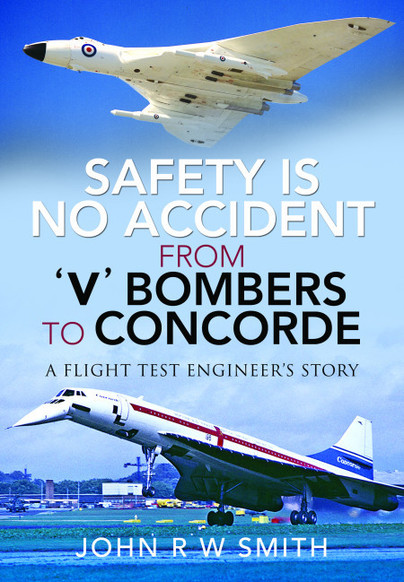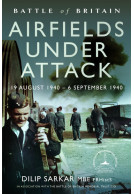Safety is No Accident: From 'V' Bombers to Concorde (Hardback)
A Flight Test Engineer's Story
Imprint: Air World
Pages: 288
Illustrations: 98 colour & black and white
ISBN: 9781526769442
Published: 3rd August 2020
(click here for international delivery rates)
Order within the next 9 hours, 21 minutes to get your order processed the next working day!
Need a currency converter? Check XE.com for live rates
| Other formats available - Buy the Hardback and get the eBook for £1.99! | Price |
|---|---|
| Safety is No Accident: From 'V'… ePub (76.0 MB) Add to Basket | £6.99 |
Flying, as everyone knows, is generally regarded as the safest means of transportation. Yet for that to be the case an enormous amount of testing is undertaken. Central to this, of course, are the test pilots, who fly the aircraft, but it is the people behind the scenes who deal with the technical aspects of the aircraft – the flight test observers and engineers.
Numerous books have been written by Test Pilots, but few, if any, from the perspective of an Aeronautical Engineer working as Flight Test Observer/Engineer in partnership with the Test Pilot. This book is an account of the author’s flight-testing career, from the 1960s to early 1980s, at Avro and the Civil Aviation Authority (CAA).
During the author’s time at Avro, he flew on the development and certification test flights of the Avro 748, 748MF, Shackletons, Nimrod and Handley-Page Victor tanker. In the CAA, his role turned to regulation, making flight test assessments of manufacturer’s prototypes and production aircraft, to check compliance with the CAA’s flight safety requirements. The scope ranged from single-engine light aircraft to large civil transport aircraft. It involved frequent visits to foreign manufacturers and also included his participation in the CAA’s Concorde certification flight test programme.
Flight testing involves risk. Advancements in the understanding of aerodynamics and an increasingly professional approach to risk management improved safety, but it would never be risk-free. Several of the author’s close friends and colleagues died in flight test accidents during this period; all on civil aircraft types. It is because of such people that the millions of flights undertaken each year are trouble-free.
There are plenty of biogs and even autobiographies about test pilots, but there are few, if any, written by flight test engineers. I wasn't sure just what to expect, but for anyone with an interest in how aircraft get tested from early prototype to in service versions this book is highly recommended.
Amazon UK Review
The first chapter gives a very detailed report of the authors routine flight test for a 'fuel tanker' Victor aircraft - that this nearly ended in total disaster, and while not typical of all (of his) test flights, is a rivetting example of how near to catastrophe things can be.
The book is in essence a career biography, and covers the authors involvement with many of the icons of the 60s and on - the Victor, Nimrod and Shackleton, through to Concorde and various less stellar domestic aircraft.
While not to everyone's taste (it is a fairly niche subject!) - the explanation of things like how a plane gets into a spin, and most importantly how to get out of one, along with the consideration of centre of gravity at every stage in any flight, are just two examples of things that never occur to anyone on their flight to some sunny holiday destination, but which we all should be grateful for!
Written in an engaging but surpisingly unemotional and almost detached way, I thoroughly enjoyed the book and would recommend it to anyone with an interest in the more technical aspects of flight and aircraft development.
5 Stars
With the tag line “From V Bombers to Concorde’ this 278 page hardback is an account of the author’s career as a Flight Test Engineer from the 1960s to the early 1980s. Initially with Avro, he was involved in the testing of the Auro 748 and variants, Shackletons, Nimrods and the Handley Page Victor tanker conversions, before moving to the UK Civil Aviation Authority and regulatory work. This involved checking the compliance of a wide range of civil aircraft with flight safety requirements, including Concorde. In between the serious work, there are many anecdotal stories of personal events that occurred and the result is a most readable book, covering test flying and aircraft development from an unusual angle….
Helicopter International - Volume 43, Number 01, 12th January 2022
As featured in: Recommended Reading
Cambridgeshire Country Life Magazine
Website of the Royal Aeronautical Society
"This book is one of the comparatively rare aviation books that is hard to put down – brilliant effort, there are plenty that are not like that.”
Customer Review
John is to be commended for chronicling a personal record of a largely analogue time that is long since passed.
RAF Historical Society Journal, No 75 (Jan 21)
The Air World imprint is proving to be the home of some outstanding aviation history and this new book looks at safety through the eyes of a flight test engineer who has worked on some of the finest and most innovative aircraft of the post WWII period. The author provides a very readable narrative, offers fresh insights and is supported by a fine selection of images, many in full colour. – Very Highly Recommended
Firetrench
Read the full review here
… well and engagingly presented, with a good balance struck between technical detail and the more human aspects of the job.
Aeroplane Monthly, February 2021
A former Hatfield aerodrome test pilot is to have an aviation book published
Welwyn and Hatfield Times, 6th May 2020
Article: ‘Aviation book to be released by retired aeronautical engineer’ as featured by
Isle of Wight County Press, 15th April 2020 – words by Dominic Kureen
Click here to listen to John R W Smith interview on
Talk Radio Europe with presenter Bill Padley on the mid morning show ‘ Let’s Talk’
Like the author, I worked for the UK Civil Aviation Authority's Flight Test Department - although as a test pilot rather then flight test engineer. This book captures a glimpse into the halcyon days of UK aviation when we were still producing some of the best and most competitive commercial aircraft in the world. The book does a good job of conveying the challenges faced by a regulator and explains many aspects of the requirements for civil certification. Although it will not be everyone's 'cup of tea' the book is well illustrated with numerous colour photographs and it provides a fascinating insight into this aspect of aviation. If you are interested in this topic you might also enjoy 'Test Pilot' by Chris Taylor.
Christopher Taylor
About John R W Smith
JOHN R.W. SMITH obtained an honours degree in Aeronautical Engineering from Bristol University in 1962. Having completed his apprenticeship, he joined Avro in 1963 as an Aerodynamicist in the Flight Development Department and, alongside this task, became a Flight Test Observer in 1964. His professional expertise expanded from aerodynamics to automatic flight control systems and navigation systems. During that time, he flew frequently with Tony Blackman who was Avro’s Chief Test Pilot. In 1974 he joined the Civil Aviation Authority (CAA) as a Flight Test Engineer. He was appointed a Member of the Royal Aeronautical Society. In 1982, he left the CAA’s Flight Department to become a Design Liaison Surveyor in the Projects Department, leading teams of CAA specialist engineers investigating the design and test results for aircraft types seeking UK certification, and on further promotion was responsible for all Light Aeroplane certification, as well as managing the CAA’s design and production approval process for UK aircraft manufacturers. In 1993, he became CAA’s Head of Aircraft Certification. John retired in 1999.
The Dangers of Automation in Airliners Accidents Waiting to Happen (Hardback)
Automation in aviation can be a lifesaver, expertly guiding a plane and its passengers through stormy weather to a safe landing. Or it can be a murderer, crashing an aircraft and killing all on board in the mistaken belief that it is doing the right thing. Lawrence Sperry invented the autopilot just ten years after the Wright brothers’ first flight in 1903. But progress was slow for the next three decades. Then came the end of the Second World War and the jet age. That’s when the real trouble began. Aviation automation has been pushed to its limits, with pilots increasingly relying on it.…
By Jack J HerschClick here to buy both titles for £43.00
















